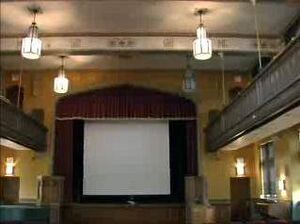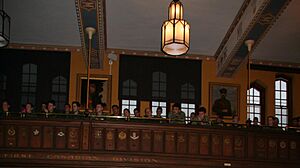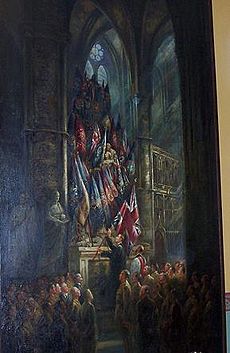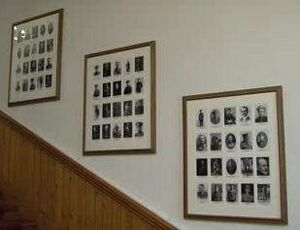Currie Hall facts for kids
Quick facts for kids Currie Building |
|
|---|---|
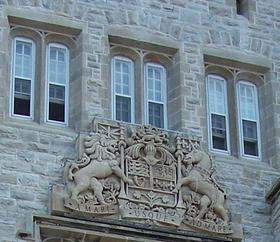
Coat of arms of Canada on Currie Hall Mackenzie Building Royal Military College of Canada
|
|
| Type | University Hall |
| Location | Kingston, Ontario, Ontario, Canada |
| Established | 1922 |
| Built | 1922 |
| Architect | Percy Erskine Nobbs |
| Architectural style(s) | Gothic Revival |
The Currie Building is an important part of the Royal Military College of Canada in Kingston, Ontario. Inside this building, you'll find Currie Hall, a large room used for special events. The building was finished in 1922. It is recognized as a special heritage building by the Canadian government.
The famous architect Percy Erskine Nobbs designed the hall. It was built right after the First World War. Sir Archibald Cameron Macdonell, who was in charge of the Royal Military College at the time, oversaw its construction. The hall was created to remember the brave Canadian Corps who fought in the war.
Currie Hall is a very important place at the college. It hosts many events, like speeches by important guests. Conferences held in Kingston often use the hall for talks and presentations. The Currie Building also has offices and a language learning center. The building is named after Lieutenant-General Sir Arthur Currie, a Canadian hero.
One cool thing about Currie Hall is its decorations. It features the symbols and battle flags of every Canadian unit that fought in France during World War I.
Contents
History of Currie Hall
The Currie Hall officially opened on May 17, 1922. General Sir Arthur Currie himself spoke at the ceremony. He said he was very proud to see the hall open. He mentioned that the hall was built to honor the brave soldiers he commanded. He also noted how the crests and battle colors reminded him of Canada's great effort in the war.
Above the main entrance, you can see the Royal Coat of Arms of Canada. It also has Canada's motto, Ad mare usque ad mare, which means "From Sea to Sea." These were carved by Maurice Joanisse. He was an apprentice carver at the time. He later became the Official Sculptor of Canada. Joanisse also carved the symbols of Sir Archibald Cameron Macdonell and General Currie.
-
The coat of arms for General Sir Arthur William Currie
Decorations and Symbols
Major Stuart Forbes painted the special symbols in the hall as a gift. General Macdonnell believed these symbols would inspire the cadets at the Royal Military College. He felt seeing the emblems of the Canadian Corps would be a great motivation.
In 2004, John Ralston Saul visited Currie Hall. He described it as an "astonishing hall." He noted how the symbols on the ceiling and walls show that Canada has a long military history. He felt the hall wonderfully captured the "grandeur and tragedy" of Canada's role in the First World War.
The initials of important commanders from the Canada Corps are on the ceiling of Currie Hall. These include General Sir Arthur Currie and others like Sir Edwin Alderson and Sir Julian Byng, 1st Viscount Byng of Vimy. The badges and battle patches of different Canadian divisions are displayed on 132 oak panels.
Provincial Shields
Edwin Tappan Adney created special three-dimensional shields. These shields represent the Canadian provinces. They are displayed throughout Currie Hall, adding to its unique decorations. Adney had worked as an engineering officer at the Royal Military College from 1916 to 1919.
Artwork in the Hall
In 1947, two large paintings by Emily Warren were hung in Currie Hall. These paintings are called Canada's Tribute, The Great War 1914–1919 and Placing the Canadian Colours on Wolf's Monument in Westminster Abbey. The first painting shows 52 sets of military flags being placed on the Wolfe Monument in Westminster Abbey for safekeeping. These paintings were first displayed in the Canadian Parliament Buildings. More recently, in 2010, 31 paintings of Canadian war memorials by F.A. (Tex) Dawson were put on display outside Currie Hall.
Memorial Staircase
When you enter the Mackenzie Building, which is connected to the Currie Building, you'll see a special staircase. This staircase was named the memorial stairway after the First World War. It was dedicated by RMC Cadet #151 Sir Archibald Cameron Macdonell. The staircase is decorated with photos of 358 former students. This includes Captain Nichola Goddard, who died while serving in the military.
Stained Glass Windows
Outside Currie Hall, there are beautiful stained glass windows. Some show images related to the Royal Canadian Sea Cadets and the Navy League Cadet Corps (Canada). One window honors David H. Gibson, a former president of the Navy League of Canada. It shows a young sailor and God at a ship's wheel. This window remembers Canadians who served at sea to defend their country. It includes a poem by H.R. Gillarm.
Other stained glass windows on the first floor show military saints. One holds a staff and shield, another is with a horse and angels. The middle window features the Royal Military College's motto: Truth, Duty, Valour. It also shows the college shield and armor.
Many of these windows were made by Robert McCausland Limited. They honor different classes of students or important military figures. For example, one window from 1973 honors the Class of 1958. Another from 1968 remembers the Dieppe Raid of August 19, 1942.




